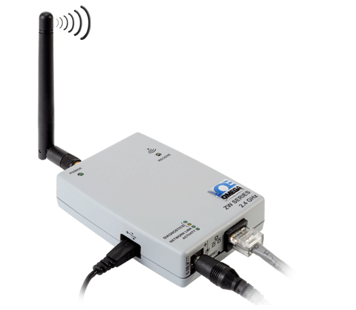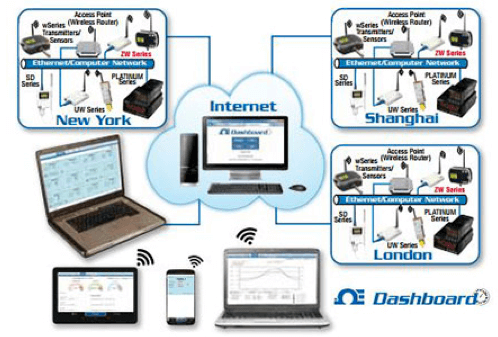IoT Technology Spotlight: Long-Range Wireless Sensing and Monitoring
IoT applications are expected to see immense growth in the coming years, especially in the areas of industrial, commercial, transportation, and environmental applications. To make it happen will require the ability to sense and transmit data from remote locations. But sensing the data from nodes placed in remote locations is one thing; transferring the data from the node to the cloud so it can be logged and monitored is quite another—this task requires long-range wireless connectivity.
Presently, the leading contenders for providing long range wireless connectivity are cellular and low-power wide area (LPWAN) networks. Both technologies have pluses and minuses. Cellular connectivity still consumes a lot of power and can also be expensive, while LPWANs as implemented by SigFox, LoRa and Ingenu may consume less power yet will require network providers to build out their networks for implementation. So, what’s the best solution for the long-range, wireless sensing and monitoring?
To get some insights regarding long-range, wireless sensing and monitoring, element14 talked to Frank Paytas from Newport Electronics. Newport Electronics markets a high-performance, long range and low-power consumption wireless sensor/transmitter system (Newport Electronics ZW-ED) that provides web-based monitoring temperature, humidity, and barometric pressure.
element14: Everyone is expecting that the Internet of Things (IoT) to explode in the coming years, fostering a lot of innovation and new product introductions. Right now, we hear about WiFi and Bluetooth as important technologies for implementing IoT. But these technologies are not long range (and not inherently secure), so they’re not appropriate for long range IoT applications. Could you give our readers some context on the state of the industry regarding wireless connectivity for long range sensing and monitoring?
Newport Electronics: Achievable range is a function of the allowable power. In the 2.4 GHz band used by WiFi and Bluetooth, our extended range ZW Series is based on an IEEE802.15.4 standard allowing higher powered transmitters and therefore supports ranges up to 1,000 meters. Another emerging technology is sub Ghz transmission in the 800-900 Mhz band, which allows even higher power and can support ranges up to 10 kilometers. Sub Ghz standards are not as well established and have different standards internationally which leads to a more complicated global solution.
element14: Newport Electronics markets a long range and low power consumption wireless sensor/transmitter system (Newport Electronics ZW-ED). How does it fit in with similar technologies? Could you give our readers the details of your technology for this application?
Newport Electronics: Different wireless applications call for differing wireless solutions, with no ‘one size’ fitting all requirements. Short range Bluetooth devices are supported by ubiquitous pairing to phones, tablets and laptops for visualization, allowing for fast integration but suffer from shorter ranges and a wider range of security issues. We have architected the ZW Series to a provide a robust Sensor Interface platform that accepts virtually every sensor we can imagine in a NEMA 4 housing. This allows us to easily switch-in different radio subsystems that address a wide range of IEEI802.15.4, Wifi, Bluetooth and sub Ghz applications.
element14: What's the maximum range that can be achieved? How does your long-range wireless technology overcome obstacles, obstructions, or interferences? How is it powered? What parameters can it sense? How adaptable is it?
Newport Electronics: Again, the range of the ZW family is determined by the radio technology used. Our ZW-ED and ZW-CM products support up to 1,000 meters; our WW-ED (WiFi) transmitters support up to 200 meters; and our Bluetooth products will typically support up to 100 meters. Powered from either a ‘wall plug’ adaptor or low cost C cell batteries, our ZW Series transmitters accept process input (0-10 Vdc, 4-20 mA), thermocouples, RTD’s, digital pulses (counters, rate, pulse width) and a growing family of self-contained probes that include digital temperature, humidity, barometric pressure and ambient light sensors.
element14: What types of applications are most conducive to long-range wireless sensing? Can you give me a few examples?
Newport Electronics: Wireless technology address two major hurdles when deploying monitoring and sensing. With no need to physically connect the devices, wireless connectivity enjoys a much lower cost of installation and, in many cases, battery powered options eliminate the need for any established ‘infrastructure’ and are inherently mobile making them a natural fit for agri-business and asset monitoring for perishable or controlled materials. As further regulations evolve to provide environmental and security monitoring, wireless systems can be easily deployed into existing systems with minimum installation costs, and avoid adding any additional loading or changes to existing control and monitoring systems.
element14: The most talked about challenge that’s reported regarding the IoT is security. How do you ensure data security, assurance, and traceability?
Newport Electronics: The ZW Series provides multiple levels of assurance and data traceability by exploiting the extremely low-power processing power now available. It is our view that in addition to knowing a ‘measurement value,’ it is increasingly important to know when the measurement was taken and a history of what device took the measurement, including time of last calibration. As in all systems, faults can occur so ensuring that data is logged at the point of measurement and at each point of transfer ensures that data is always recoverable in case of communication or upstream system errors.
element14: What are the differentiating benefits of the solution that Newport Electronics is providing as compared to other solutions in marketplace today?
Newport Electronics: We are in a unique position to exploit over 50 years of experience in basic measurement and process control technology, 15 + years of network technology, and 10 years of wireless technology experience to offer a powerful family of wireless solutions that may be easily integrated into a wide range of process, manufacturing and environmental monitoring applications. Offering a robust, standardized measurement platform coupled with flexible radio transmission solutions with a focus on data assurance, the ZW Series of products form the foundation for application specific solutions for the foreseeable future.

ZW-E Wireless Transmitter

ZW-REC Wireless Receiver
The Newport Electronics ZW-ED Series is a rugged high-performance, long range and low-power consumption, wireless sensor/transmitter system provides web-based monitoring temperature, humidity, and barometric pressure and a wide range of process/sensor inputs.

These wireless devices are designed for demanding industrial applications indoors and harsh outdoor environments. The electronics are protected in a rugged weatherproof polycarbonate NEMA 4 (IP65) rated housing. A variety of compatible probes are available to suit your application.